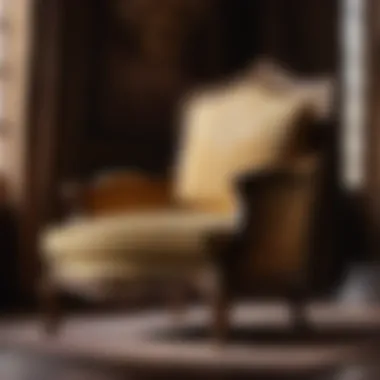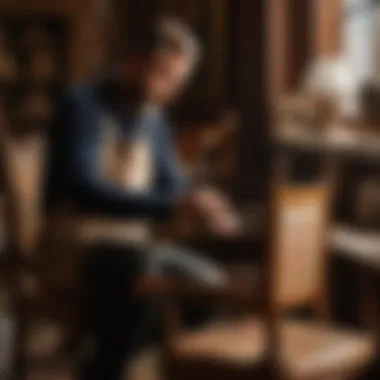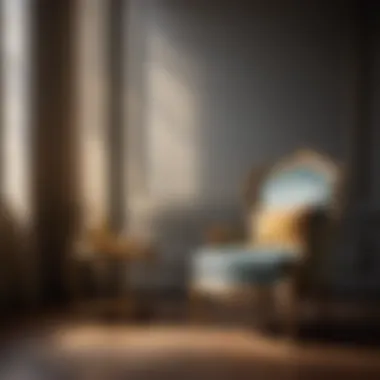Materials:
- Fabric: 5 yards of high-quality upholstery fabric in the desired color and pattern to fully cover the chair.
- Foam padding: 2 inches thick foam padding, cut to the shape and size of the chair seat and backrest for comfort.
- Batting: 3 yards of polyester batting to provide a smooth finish and added softness.
- Upholstery tacks: A box of 500 decorative upholstery tacks for securing the fabric in place neatly.
- Thread and needle: High-quality thread in a matching color and a sturdy needle for sewing tasks.
- Scissors: Sharp scissors for cutting fabric, foam, and batting accurately.
- Staple gun: A heavy-duty staple gun for attaching fabric securely to the chair frame.
DIY Steps:
- Preparation: Begin by removing the existing fabric, foam, and batting from the chair carefully to reveal the frame.
- Cutting Materials: Measure and cut the new fabric, foam padding, and batting according to the dimensions of the chair parts.
- Attaching Foam: Secure the foam padding to the seat and backrest using adhesive or upholstery spray glue for a snug fit.
- Layering Batting: Layer the polyester batting over the foam, ensuring a smooth and even surface for the fabric to lay on.
- Upholstering: Place the cut fabric over the chair frame, starting with the seat and meticulously working around corners and edges. Use the staple gun to fasten the fabric securely.
- Trimming and Finishing: Trim any excess fabric and tuck in the edges neatly for a clean and professional finish.
Technical Aspects:
- Tools: Ensure you have a good-quality staple gun, sharp scissors, and a sturdy needle and thread for upholstery tasks.
- Timing: Allocate a full day for this project, considering the meticulous cutting, layering, and finishing involved.
- Critical Techniques: Pay special attention to stretching the fabric evenly to avoid creases and wrinkles, staple gun handling for secure attachment, and precise cutting for a polished look.
DIY Project Process:


- Start by meticulously planning each step and measuring materials accurately to ensure a perfect fit.
- Follow the sequence of tasks from preparing the chair frame to the final trimming and finishing touches.
- Trouble Tips: In case of fabric bunching or uneven attachment, carefully remove staples and readjust the fabric before resecuring.
This comprehensive guide provides detailed instructions and meticulous measurements to aid in the successful recovery of a chair, infusing a new life into your furniture piece.
Introduction


The introduction section sets the stage for a detailed exploration of the financial considerations involved in chair recovery. By delving into the realm of materials, labor, and upholstery intricacies, readers gain a comprehensive understanding of the monetary investments required in this process. Furthermore, the introduction serves as a precursor to the subsequent sections that will delve deeper into the specific elements influencing these costs.
Factors Affecting Cost


This section delves deep into the critical aspects that impact the overall cost involved in chair recovery. Understanding the factors that drive these expenses is vital for anyone embarking on a furniture restoration project. Three key elements play a significant role in determining the cost: The Type of Fabric, Labor Costs, and Additional Materials Required.
Type of Fabric
Selecting the right fabric for chair recovery is a crucial decision that influences both the aesthetics and the cost of the project. High-quality, durable fabrics might come at a higher price point but offer longevity and a luxurious look. Conversely, more budget-friendly options can reduce initial costs but may require more frequent reupholstering in the future. The choice of fabric not only affects the visual appeal of the chair but also contributes significantly to the overall expenses involved.
Labor Costs
Labor costs are a significant component in the overall cost analysis of recovering a chair. Skilled upholsterers with intricate detailing and advanced techniques may command higher hourly rates, impacting the total expenses incurred. The complexity of the design and the skill level of the upholsterer also play a pivotal role in labor costs. A more intricate design requiring precise workmanship will naturally increase the labor expenses, making it essential to factor in these aspects when estimating the overall project budget.
Additional Materials Required
Apart from fabric and labor, there are additional materials essential for chair recovery that contribute to the total cost. These materials may include cushioning, springs, webbing, nails, and other supplies necessary for a successful restoration. The quality of these additional materials can vary, affecting both the durability of the recovered chair and the overall cost. It is crucial to consider the type and quantity of these materials to ensure a comprehensive cost analysis and avoid any unexpected expenses during the restoration process.
Calculating Labor Costs
When embarking on the journey of recovering a chair, one of the pivotal aspects to consider is the meticulous calculation of labor costs. This essential step plays a fundamental role in determining the overall expenses involved in the restoration process. By delving into the realm of calculating labor costs, individuals gain valuable insights into the financial implications of chair recovery. Understanding the intricacies of labor expenses allows for a more accurate estimation of the total investment required to breathe new life into a piece of furniture.
Within the realm of calculating labor costs, several specific elements warrant attention. Firstly, the expertise and efficiency of the upholsterer significantly influence the total labor expenses. An experienced upholsterer with advanced skills may command higher hourly rates but could potentially deliver superior results in a more time-efficient manner. Balancing cost and quality in terms of labor is crucial for achieving a successful chair recovery within a reasonable budget.
Moreover, the duration of the project directly correlates with hourly rates and, consequently, total labor costs. Complex chair designs that demand intricate detailing and specialized techniques may prolong the upholsterer's work hours, leading to increased expenses. Therefore, evaluating the complexity of the design at the outset is paramount for accurate cost estimation and project planning.
Lastly, the skill level of the upholsterer plays a significant role in determining labor costs. Highly skilled professionals proficient in various upholstery techniques may command higher rates due to their expertise and precision. However, their level of craftsmanship often translates into impeccable results that justify the investment. Understanding the skill level required for a particular chair recovery project is essential for aligning expectations and budgetary considerations.
In essence, calculating labor costs is a pivotal aspect of the chair recovery process, influencing both budget planning and project outcomes. By dissecting the components of labor expenses, individuals can navigate the financial landscape of upholstery with precision and clarity. This deep dive into labor cost calculation equips enthusiasts and homeowners with the knowledge needed to pursue chair recovery projects effectively and efficiently.
Estimating Fabric Costs
Estimating fabric costs is a crucial aspect of the overall cost analysis when it comes to recovering a chair. The choice of fabric not only impacts the aesthetic appeal of the chair but also plays a significant role in determining the durability and comfort level of the upholstery. Selecting the right fabric is essential to achieving a balance between style and functionality. Different fabrics come with varying price points, maintenance requirements, and longevity, all of which need to be carefully considered when estimating fabric costs.
Factors such as the type of fabric - whether it's natural, synthetic, leather, or a blend - influence the overall cost. Natural fabrics like cotton or linen may be more affordable but could be less durable compared to synthetic fabrics such as polyester or nylon. Leather, on the other hand, is luxurious but comes at a higher price point. The quality of the fabric, expressed in terms of thread count, fiber strength, and weave complexity, also affects the cost. High-quality fabrics are more expensive but offer better resistance to wear and tear, making them a more cost-effective choice in the long run.
Moreover, the quantity of fabric needed plays a significant role in cost estimation. It's essential to accurately calculate the yardage required based on the chair's size, design complexity, and any pattern matching considerations. Pattern matching, in particular, adds another layer of intricacy to fabric estimation. Matching patterns on fabric seams to create a seamless look requires additional yardage and skill, impacting both the material cost and labor hours.
In summary, estimating fabric costs involves a thorough evaluation of fabric type, quality, quantity, and pattern matching intricacies. By considering these factors in detail, one can arrive at a more accurate projection of the total fabric expenses involved in chair recovery.
Quality of Fabric
When it comes to selecting fabric for chair recovery, the quality of the material is paramount. High-quality fabric not only enhances the visual appeal of the chair but also contributes to its longevity and comfort. The quality of fabric is determined by various factors such as the fiber content, weave construction, and finish.
Fabrics with high thread counts and tightly woven fibers are typically more durable and resistant to abrasion, ensuring that the upholstery retains its appearance over time. Additionally, fabrics with specific finishes, like stain-resistant coatings or UV protection, offer added functionality, making them suitable for different environments.
Investing in high-quality fabric may incur a higher initial cost, but it pays off in terms of longevity and performance. Cheaper fabrics may save money in the short term, but they are more prone to wear and tear, leading to premature replacement. Hence, choosing a high-quality fabric is a cost-effective decision in the long run, offering durability and aesthetic appeal.
Fabric Quantity Needed
Determining the adequate quantity of fabric required for chair recovery is a meticulous process that influences the overall cost estimation. The amount of fabric needed varies depending on factors such as the chair's dimensions, design complexity, and pattern repeat.
Before purchasing fabric, precise measurements of the chair's upholstery surface must be taken to calculate the yardage accurately. Upholstery patterns, especially on larger pieces of furniture, may require additional fabric to ensure proper alignment and pattern continuity across different sections.
Failing to account for the correct fabric quantity can result in costly reorders and delays in the recovery process. It is essential to consult with upholstery professionals or refer to fabric calculators to determine the exact yardage needed based on the specific chair design and pattern requirements.
Pattern Matching
Pattern matching is a critical consideration in fabric selection for chair recovery, particularly for chairs with intricate designs or visible seams. Matching patterns on upholstery fabric involves aligning motifs or textures seamlessly along the seams to create a cohesive look.
Achieving pattern continuity requires meticulous cutting and positioning of fabric pieces to ensure that the design flows seamlessly from one section to another. This process demands skilled craftsmanship and attention to detail to maintain the integrity of the pattern throughout the upholstery.
Pattern matching adds a level of sophistication to the chair's appearance but also increases the fabric wastage and labor time involved. The intricacy of the pattern and the number of fabric repeats necessary to match the design influence the overall fabric cost and work hours required for the recovery project.
Additional Costs
In the realm of recovering a chair, the section on additional costs holds significant importance in understanding the full scope of expenses involved in the process. These additional costs go beyond the fundamental materials and labor elements, encompassing various crucial factors that contribute to the overall expenditure associated with chair recovery. By delving into the intricacies of additional costs, individuals can gain a comprehensive understanding of the financial considerations that play a pivotal role in the revitalization of furniture pieces.
Exploring the realm of additional costs within this article sheds light on the supplementary expenses that can impact the total budget of chair recovery projects. These costs extend beyond the basic fabric and labor components, encompassing aspects such as transportation, upholstery supplies, and overhead expenses. Each of these elements plays a crucial role in shaping the final cost analysis of recovering a chair, emphasizing the need to consider a holistic approach towards budget estimation.
The discussion on additional costs not only provides readers with a detailed breakdown of financial considerations but also serves as a practical guide for individuals embarking on chair recovery endeavors. By understanding the significance of additional costs, readers can make informed decisions regarding budget allocation and expenditure management, ensuring a smoother and more structured approach towards furniture restoration projects.
Transportation
The aspect of transportation forms a critical component within the realm of additional costs when it comes to chair recovery. The process of transporting materials, furniture pieces, and upholstery supplies to and from various locations can significantly impact the overall expenses incurred during the project. From the initial acquisition of fabric to the delivery of the revitalized chair, transportation costs play a vital role in determining the feasibility and cost-effectiveness of the entire endeavor.
When considering transportation costs, factors such as distance, mode of transport, and logistics coordination come into play. Individuals engaging in chair recovery projects must account for transportation expenses in their budget planning to avoid any unforeseen financial burden. By acknowledging the significance of transportation costs within the context of chair recovery, individuals can streamline their budgeting process and ensure efficient resource allocation.
Upholstery Supplies
Upholstery supplies represent another fundamental element within the realm of additional costs when it comes to chair recovery. These supplies encompass a wide range of materials, tools, and equipment essential for the revitalization and restoration of furniture pieces. From foam padding and fabric glue to staple guns and cutting tools, the array of upholstery supplies required for chair recovery projects can contribute significantly to the overall expenditure.
Understanding the importance of upholstery supplies is crucial for individuals embarking on chair recovery endeavors. By identifying the essential materials and tools needed for the project, individuals can create a comprehensive list of upholstery supplies and estimate the associated costs accurately. This proactive approach not only facilitates efficient resource management but also ensures the seamless execution of chair recovery projects within the predefined budget constraints.
Overhead Expenses
The consideration of overhead expenses adds a layer of complexity to the realm of additional costs associated with chair recovery. These expenses encompass indirect costs that are not directly attributable to a specific chair recovery project but are essential for the overall functioning and sustainability of upholstery businesses or DIY endeavors. From rent and utilities to administrative costs and insurance fees, overhead expenses contribute to the operational overhead that impacts budget planning and financial viability.
Final Cost Calculation
In the realm of chair recovery, the final cost calculation stands as the pinnacle of meticulous planning and foresight. This section delves into the crucial stage where all the disparate elements of cost - be it the fabric, labor, additional materials, transportation, upholstery supplies, and overhead expenses - culminate into a concise and comprehensive figure. Not merely a summation of expenses, the final cost calculation is a strategic analysis that accounts for every minutiae, ensuring accuracy and transparency in the budgeting process.
As we scrutinize the elements that constitute the final cost calculation, it becomes evident that each component plays a vital role in shaping the overall expenditure. From the quality and quantity of fabric to the hourly rates of skilled upholsterers, every detail is meticulously considered to arrive at an estimable final cost. This meticulous approach not only provides a clear financial roadmap but also enables individuals to make informed decisions regarding budget allocation and resource management.
Moreover, conducting a thorough final cost calculation offers numerous benefits beyond mere financial estimation. It empowers individuals to anticipate potential cost fluctuations, navigate unforeseen expenses, and exercise greater control over their budget. By delineating all expenses and factoring in contingencies, individuals can mitigate financial risks and ensure a smoother chair recovery process.
In the context of this article, the final cost calculation serves as the culmination of a detailed exploration into the intricacies of chair recovery costs. It encapsulates the essence of prudent planning and judicious decision-making, painting a holistic picture of the financial landscape involved in revitalizing a piece of furniture. By shedding light on the importance and nuances of final cost calculation, this section equips readers with the knowledge and insight necessary to embark on their chair recovery journey with confidence and clarity.





